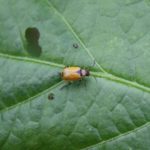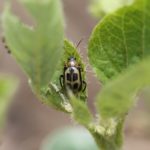I’ve had several calls from the Mississippi River Bottoms and the southern counties of West Tennessee about high numbers of bean leaf beetles, sometimes as many as 200-400 per 100 sweeps. Bean leaf beetle feed primarily on foliage in the upper part of the canopy. They occasionally will feed on pods, although this occurs rarely and is hard to predict.
In the book, we recommend treatment when bean leaf beetle numbers average 2 beetles per sweep (200/100 sweeps) anytime between early flowering (R1) and full seed (R6). However, I generally prefer to treat based on defoliation levels rather than beetle numbers, using a threshold of 20-25% defoliation from R1 – R6, relaxing this threshold to 30-35% defoliation for the next 7-10 days after reaching R6, and not treating after this point. With this insect, it is important to judge defoliation averaged throughout the canopy because their feeding is concentrated only in the upper one-third.
When treating for high numbers of beetles, it is common for beetles to re-infest fields quickly. You may see similar numbers of beetles 7-10 days after an application. This is the primary reason I prefer to treat based on defoliation. Otherwise you can get on a treadmill of treating beetle numbers even though defoliation levels may not be that high.
Insecticide choice can be a little tricky. Pyrethroid insecticide may or may not work pretty well, depending upon location. For example, they have always provided good control in my tests in Jackson and Milan. Unfortunately, some populations have developed resistance to pyrethroids, and I often get complaints from counties bordering Mississippi and Arkansas (which is also the places populations are generally highest). Adding 0.5 lbs of Acephate (e.g., Orthene) with a pyrethroid insecticide will help overcome this resistance. The insecticides Belay and Sevin also work well when battling pyrethroid resistant beetles.
Although stink bug populations have remained generally low. I’ve also had several reports of corn earworm and loopers. For the most part, these have been populations that are below or close to threshold levels. However, it is important to monitor late maturing soybean for corn earworm infestations over the next 2-3 weeks. Infestations of soybean loopers to the south of Tennessee are occurring earlier than usual, which is often a sign of things to come in Tennessee. Don’t forget to monitor for loopers and stink bugs, especially in late maturing soybean fields and as the season continues to progress.
Note: Populations of soybean looper that are resistant to diamide insecticides such as Belt, Prevathon and Besiege have been confirmed in the Southeast and Mid-South. My counterparts are getting some reports of unsatisfactory control to the South. It seems a foregone conclusion that the efficacy of this class of chemistry on soybean loopers in quickly waning. My suggestion is to test the waters before treating a bunch of acres with a diamide insecticide for soybean loopers. In other words, look before you leap. It is possible they may not provide satisfactory control, in which case we can shift to products like Intrepid, Intrepid Edge, Blackhawk, or Steward.




